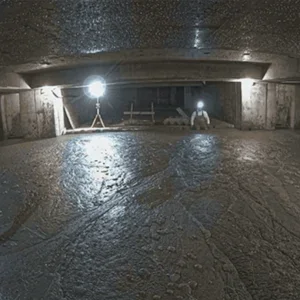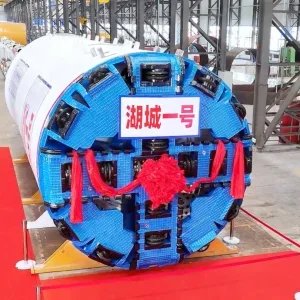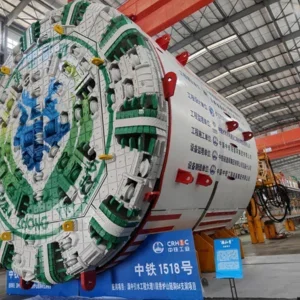The Lærdal road tunnel, constructed from 1995-2000, is located in the spectacular fjord landscape of western Norway. It provides a ferry-free, year round, road connection between Oslo and Bergen, the two largest cities in the country. It takes 20 minutes to drive through the 24.5km tunnel, which has four tunnel sections linked by three large caverns designed to allow the turning of long trucks. Each cavern is lit with bright colours to break driver monotony. The average traffic is 1000 AADT, peaking in the tourist season at 2000-3000 vehicles/day. The construction cost (year 2000) was US$5000/m. The tunnel was excavated in part by contractor NCC Eeg-Henriksen Anlegg AS and in part by the local Public Roads Administration’s construction division, both with long tunnelling experience. The owner, the Public Roads Administration of the county of ‘Sogn and Fjordane’, managed the contracts, whilst the Norwegian Geotechnical Institute (NGI) was the geotechnical consultant for the owner.
The highest rock cover is 1450m, corresponding to a vertical stress of close to 40MPa. More than 20km of the tunnel has at least 800m of cover. The dominant rock types are banded or veined gneisses, often of gabbroitic composition, massive syenitic or monzonitic augengneisses, all Precambrian. Mica-rich schistose gneisses and bands of amphibolites occur to a lesser extent. The jointing is normally scarce to moderate, although some jointed weakness zones occur, as well as a few fault zones (Figure 1).
Pre-construction site investigations were limited to engineering geological surveying of the area above and around the alignment, combined with geotechnical classification according to the Q-system. This was performed by NGI, who wrote the geotechnical report included in the tender documents. No core drilling or stress measurements were performed prior to construction, which is not unusual for such projects in Norway. Interpretations were based on extensive experience from similar projects in the district.
In glaciated fjord landscapes tunnelling in the high and steep valley-sides is often exposed to rock stress relief phenomena. These range from crackling or gun shot sounds to immediate or long term rock spalling (‘strain bursting’). In connection with pre-existing joints, large rock slabs may loosen without any warning. Such conditions are known from many tunnels projects in Norway. The worst cases of rock bursting in the form of crushed rock ‘popping’ out of the tunnel contour or work face are however less common.
Contract type
In the last few years, the Public Roads Administration has often divided long tunnels into two contractual lots; one to be tendered out and the other assigned to one of its own construction divisions. The discussion in this paper about the contractual aspects refers to the tendered section of tunnel constructed by NCC Eeg-Henriksen Anlegg AS. The contract was a unit price (or unit rate) contract. This type of contract has a long tradition in Norwegian tunnelling, it was developed and refined during the hydropower boom from the 1960’s, over a period of 20 years, until the mid 1980’s; 2600km of tunnels were constructed without litigation(1)!
The unit price contract is based on simple, but crucial principles: all important geological features have to be foreseen; all work activities have quantities for pricing (the ‘unit prices’); and all activities influencing progress have time parameters to regulate the construction time (‘standard capacities’).
For this type of contract to be successful reference ground conditions must be described in a geotechnical report for the tender, including interpretations of expected conditions. The quantities in the Bill of Quantities (BoQ) must be set after the geotechnical advisor’s best estimate. When the parties are experienced in tunnelling, regulation of the construction time and the payment becomes a matter of routine, based on the quantity surveying. This works well even for large variations in quantities compared with BoQ, unless unforeseen or significantly worse than expected conditions are encountered.
Contract specifics
The contract for the Lærdal tunnel included the usual rock support measures for rock stress problems, such as end anchored rock bolts (polyester type) and steel fibre reinforced sprayed concrete. Unit prices were valid for variations of +/- 100% in relation to the quantities in BoQ, as normal in the Public Roads Administration’s contracts. Other relevant regulations in connection with this were: a requirement of 60m advance rate per week per face, including risk of delays due to fault zones, snow problems outside the tunnel etc.; the general specifications specified the normal stabilisation sequence as scaling, bolting, sprayed concrete; cost and time of scaling at face was included in the excavation unit price, i.e. there were no separate pay items or time adjustment factors for such scaling.
The first requirement is unusual, but was probably included due to the exceptional length of the tunnel. The stated advance rate indicates that a normal sequence of stabilisation was considered sufficient, as it could not be achieved otherwise. The latter regulation follows recent practice by the Public Roads Administration, presumably to avoid discussions about necessary scaling time. In the view of this author, this allows little flexibility for varying conditions. It can be argued that the fact that no specific regulations were included for high intensity rock spalling and bursting confirms that unusual conditions were not expected to any significant extent. The BoQ indicated a normal level of rock support per metre tunnel. Expected final manual scaling of areas not covered by sprayed concrete amounted to approximately 50% of the tunnel contour. A review of the geotechnical report showed:
The contract specifically required tenderers to perform their own evaluation of geological conditions. This is normal and reasonable. The contract also stated that the tenderers should do their own site investigation if necessary for their evaluations. This author does not find this reasonable, considering the time (two months) available for tender and that the owner had not found it necessary to perform rock stress measurements or rock material testing. However, based on available experience, there was no reason to doubt the evaluations in the geotechnical report. It appeared reasonable to conclude that no unusual problems were to be expected.
Experienced conditions
During the initial excavation of the 2.1km adit tunnel, rock pressure problems occurred. In the main tunnel advance rates varied initially from 30m to 85m per week depending on conditions. Moderately intense spalling and slabbing was encountered most of the time. Where heavy spalling occurred, it was not possible to maintain the anticipated progress of 60m per week. Rock stress measurements were performed on two locations with moderate stress and spalling, indicating a high sub-horizontal stress in the order of 30MPa to 33MPa, and somewhat lower vertical stress than could be expected from the overburden. Deformation was monitored at two locations with multipoint borehole extensometers. Endoscope measurements, to identify the depth of release cracking outside the tunnel contour, were performed in more than 100 drill holes, distributed over the tunnel. The results of these rock investigations, which improved understanding of the rock mass behaviour(2, 3), are beyond the scope of this article.
Observations of the rock mass behaviour showed that the massive gneisses behaved brittle and often generated spalling combined with sounds from crackling to gun shot sounds. These were the stiffest rocks with E-module in the order of 50GPa. The schistose gneisses and amphibolite, with E-module of 20-30GPa, seldom gave any noise, and sustained significant deformations before spalling occurred. These rock types could undergo long lasting deformations. The presence of joints normally reduced the intensity of the spalling, but could release large slabs or blocks, frequently without any warning. Heavy rock bursts caused violent ejection of sharp edged rock plates, crushed rock ‘popped’ out or moved steadily into the tunnel from the roof, the walls or the tunnel face itself. Heavy spalling often occurred on the border between the stiffer and the softer rock types, presumably because the stiffer rocks attract more stress and can sustain less strain than the softer rocks.
In the early phases of tunnelling it became obvious that where the rock stress problems were most intense it was not sufficient to apply sprayed concrete after scaling and bolting in the normal manner. This did not provide safe working conditions. After some smaller accidents and one that resulted in permanent injury, and some ‘near misses’, the face crew became worried about the unpredictable behaviour.
Besides the characteristics described above other problems occurred: the drilling jumbo would ‘jump’ due to spalling in the floor; rock flakes were thrown up to 20m from the face; drill rods would get stuck during blast hole or probe hole drilling due to crushing and cracking in the drill holes; spalling or loosening of slabs from the face during charging of explosives; increased spalling during rock surface washing before spraying of concrete; torn rock bolts due to large deformations (in some cases cutting of bolts would trigger deformations of several centimetres); in the more intense situations, manual scaling was hazardous, and mechanical scaling could last until 1m-2m was ‘excavated’ outside the tunnel periphery. The contractor and owner embarked on a programme to improve procedures. In areas of intense spalling, revised procedures were as follows:
During the tunnelling, the new alkali-free accelerators became available. These allowed the application of thicker layers of sprayed concrete with higher early strength. This measure proved favourable and was agreed by both parties. A higher unit price for the improved mix design was negotiated.
Tunnelling proceeded according to the new procedures, including the new mix design, with improved advance rates and safety. However, the contractor had accumulated losses compared to his estimates, due the delays in the early phases. He subsequently raised a claim that amounted to more than 20% of the total cost for his section of the tunnel. The owner disagreed and maintained that the conditions were within the scope of the contract.
The experiences with respect to rock mass behaviour and necessary support procedures were of a similar nature for the tunnelling from the west portal, performed by the Public Roads Administration’s construction division. The overall average rock support measures were 6.9 rock bolts (all types with lengths of 2.5m-5m) and 1.8m³ steel fibre reinforced sprayed concrete per metre tunnel. This represented an increase of 3% and 38% respectively against the anticipated consumption (for BoQ) of 6.7 bolts and 1.3m³ sprayed concrete per metre. Of the bolts, end anchored bolts for rock stress problems increased 16% from 4.9 to 5.7 per metre tunnel. The breakthrough was achieved after 4.5 years of tunnelling, mostly on three faces.
Independent assessment
In a final attempt by the contractor to solve the disagreement with the owner out of court, the contractor assigned the author of this paper to perform an independent assessment of the expected and the encountered conditions. This was based on a review of the tender documents (summarised above) and a review of available follow-up documents. It included a site inspection with observations along tunnelled sections and at the faces. This assessment concluded:
A quantification of the effects needed an extensive effort of reviewing the detailed work records, shift by shift. This exercise would be better performed by the parties at site.
Settlement
The owner found the independent assessment report to be balanced, and the central public road authorities allowed the local project management of the owner to resume negotiations with the contractor. At site, the detailed work records were worked through to determine the extent of the delays caused by the conditions. Settlement was reached without litigation.
For the whole tunnel, the total cost increase due to the rock stress problems amounted to less than 10%. This was not at least due to the co-operation between the parties, which resulted in improved progress rates.
Conclusions
It is possible with modern stabilisation measures to deal safely and effectively with intense rock spalling and rock bursting. This involves sensible use of mechanised scaling followed by fibre reinforced sprayed concrete and subsequent rock bolting with end anchored rock bolts. Co-operation between the parties is crucial. Site investigations should be aimed at determining the potential for extreme situations, as well as the typical.
Such conditions are hard to predict, and even expensive site investigations may not be conclusive. Therefore, tender documents must allow for the occurrence of such extreme situations by inclusion of appropriate clauses for suitable measures. Then these measures can be priced and time regulations included in the contract. Such technical and contractual measures can be included in a unit price contract, once a realistic view of the potential hazards is taken and the characteristic requirements of the unit price contract are respected. If such measures are implemented in a balanced manner, the need for difficult negotiations afterwards is minimised.
Related Files
Fig 1 – Longitudinal section of the 24.5km Lærdal road tunnel (after Grimstad, 1999) and position map inset







